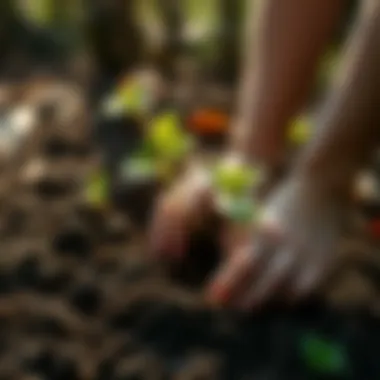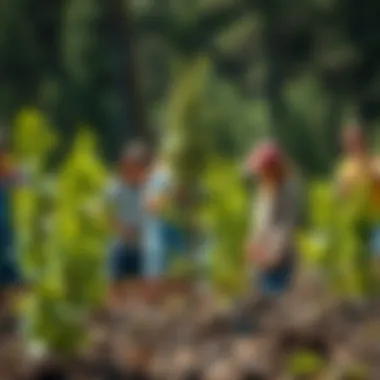Plant a Tree Gift: Cultivating Environmental Connections


Intro
The simple act of planting a tree as a gift can resonate with generations to come. It’s more than just a nice gesture; it reflects a commitment towards nurturing our planet. Trees stand as silent guardians of our environment, playing crucial roles in maintaining ecological balance. As we dive into the intricate world of tree gifting, we'll explore not only the history and significance behind this noble act but also practical steps needed to make meaningful contributions to our ecosystems.
Gifting a tree could be as practical as it is symbolic. It invites a deeper connection to nature. When we consider gifting a tree, it is essential to think about what type of tree is suitable and the local ecological context. The nuances vary widely, akin to selecting a fabric for a tailored suit, ensuring it fits the landscape and the local climate. This discussion will guide both the well-meaning and the environmentally conscious givers towards understanding the layers of meaning behind their gift.
Overview of Forestry Practices
Importance of Foresting
Forests are often seen as the lungs of the Earth. They provide oxygen, store carbon, and host vast biodiversity. The importance of forests stretches beyond intimate environmental contributions; they play a vital role in human life, economy, and culture. Historically, many communities have relied on the resources provided by forests for their livelihoods, traditional practices, and even spiritual sustenance.
The repercussions of deforestation and unsustainable land management tactics can yield dire consequences. Fast-forwarding many years, the forests we now see could become a mere shadow of their former self without conscientious management and robust stewardship.
Types of Forestry Practices
Understanding forestry practices is at the core of effective tree gifting. Numerous styles exist, each with distinct benefits and philosophies. Some notable practices include:
- Sustainable Forestry: This approach focuses on maintaining forest ecosystem integrity while providing for human needs.
- Selective Logging: Rather than clear-cutting, this method involves selectively removing trees, thus minimizing damage to the ecosystem.
- Reforestation: Following deforestation, planting trees in those areas re-establishes the forest’s life cycle and habitat.
- Agroforestry: By integrating trees and shrubs into traditional farming practices, this strategy not only bolsters crop yields but fosters biodiversity.
Each practice embodies a philosophy of balance, illustrating how human intent can blend harmoniously with nature’s rhythms. This insight primarily informs individuals seeking to plant a tree—amplifying its effect on the environment.
"Planting a tree is like investing in nature’s bank. The dividends call forth fresh air, beauty, and biodiversity; a true gift that keeps on giving."
Best Practices for Sustainable Woodland Stewardship
Principles of Sustainable Forestry
Engaging in sustainable woodland stewardship means adhering to principles that protect forest ecosystems. The essential tenets include understanding the local environment, organizing community involvement, and implementing practices to maximize efficiency while minimizing harm. Developing a long-term management plan that aligns with ecological goals is a vital step. This encourages healthy aging trees, rich habitats, and diverse flora and fauna.
Techniques for Land Management
Adopting certain land management techniques can enhance the success of tree gifting initiatives. Some efficacious methods include:
- Soil Health Improvement: Regularly testing and amending soil can invigorate growth.
- Invasive Species Control: Managing invasive species can safeguard the native biodiversity.
- Restoration Plantings: Undertaking the challenge of restoring degraded areas ensures that young trees have a thriving environment to grow.
These strategies can transform the tree-gifting endeavor into a launchpad for long-term community benefits. Connecting individuals with these practices reinforces the purpose behind their actions, emphasizing their role in a broader ecological framework.
Innovative Techniques in Forestry
Latest Technological Advancements
Emerging technologies have started reshaping forestry practices. Drones, for example, enable precise monitoring of large forestry areas. New planting techniques using high-quality saplings rather than seeds can open doors to quicker forest recovery.
Integrating Traditional Knowledge with Modern Science
There is immense value in merging traditional ecological knowledge with modern scientific methods. Understanding historical practices provides insights into what could be valuable for contemporary efforts in forest management. For instance, indigenous peoples’ land management practices offer sustainable approaches honed through generations.
Gifting a tree, then, becomes a meaningful act of bridging modernity with traditions, recognizing that the past holds insights crucial for the present and future.
For more resources on sustainable practices, consider checking out these links: Forest Conservation Resources, Sustainable Forestry Guidelines and Agroforestry Systems.
The Concept of Gifting a Tree
Gifting a tree is more than just a thoughtful present. It symbolizes a deeper connection to the environment, showcasing both ecological awareness and personal commitment. As more individuals and communities wrestle with climate change and biodiversity loss, the idea of gifting trees resonates as a beacon of hope and action. It emphasizes not merely gifting a physical object, but sowing the seeds for a greener future.
Understanding the Sentiment Behind Tree Gifting
When someone chooses to gift a tree, the sentiment behind it often reflects an individual’s values and hopes for the recipient. Trees, in their essence, represent life, growth, and sustainability. They have a unique ability to foster connections—relationships weathered by time can mirror the endurance of a tree.
Imagine a scenario where a parent gifts their child a sapling on their birthday. This act serves multiple purposes: it is a celebration of life, a lesson in responsibility, and a symbol of trust in the future. The child learns not only to care for the tree but also to appreciate the environment. This act can strengthen the bond between parent and child, rooted in shared values.
Alternatively, when a couple plants a tree to commemorate their wedding, they not only create a lasting memory but also physically contribute to the planet’s health. It’s poignant—each ring in the trunk represents the years of their journey together. As they tend to the tree, they nurture both their love and the environment.
The sentiment behind gifting a tree encapsulates nurturing connections, instilling values, and promoting sustainability, all within a single act.


Historical Perspectives on Trees as Gifts
Looking back through history, we can observe that trees have often been revered and gifted as symbols of prosperity. Ancient civilizations, like the Greeks and Romans, celebrated trees in their mythology and daily life. For instance, the olive tree has long been a symbol of peace and victory; gifting an olive branch represents extending peace—a notion still resonating today.
In many indigenous cultures, trees hold a sacred status. Trees such as the cedar and oak are not merely gifts; they are entwined with spirituality and tradition. Gifting these trees carries a rich significance, preserving ancient beliefs while also honoring the bond between humanity and nature.
In more recent history, during the environmental movements of the 20th century, gifting trees gained traction as a grassroots effort to combat deforestation and promote reforestation. Planting a tree became a political statement, an assertion of one’s commitment to sustainability and ecological integrity. Particularly in the 1970s, tree planting events became communal efforts, joining individuals across borders in a quest to restore balance to the earth’s ecosystems.
Thus, the historical tapestry woven with trees as gifts reveals deep-rooted significance across diverse cultures, connecting people through time and underscoring the importance of nurturing both relationships and the environment.
Ecological Benefits of Planting Trees
Planting trees isn’t just a pleasant pastime; it’s an investment in the health of our planet. Amid the ongoing climate crisis, the importance of trees in supporting a rich and interconnected ecosystem cannot be overstated. From capturing carbon emissions to fostering biodiversity, trees play a pivotal role in our environment. Understanding these ecological benefits sheds light on the value of gifting a tree.
Carbon Sequestration: A Growing Concern
The term carbon sequestration might seem like technical jargon, but it refers to a fundamental process in combating climate change. Trees absorb carbon dioxide—a greenhouse gas—during photosynthesis, effectively reducing the amount of CO2 in the atmosphere. Research has shown that one mature tree can absorb up to 48 pounds of carbon dioxide each year.
By gifting a tree, individuals can directly contribute to this carbon capture initiative. In an era where greenhouse gas concentration continues to rise, this small act carries a large impact. With millions of people participating, even a simple gift can accumulate collectively, creating a noticeable reduction in atmospheric carbon levels. It’s like hitting two birds with one stone: fostering personal connections while enhancing planetary health.
Enhancing Biodiversity in Local Ecosystems
Trees serve as crucial habitats for a wide array of wildlife. Birds, insects, and other creatures find refuge, food, and nesting sites among their branches. By planting a tree, you're not only beautifying spaces but also providing vital ecosystems for these organisms.
Here are some specific ways trees promote biodiversity:
- Food Source: Many trees bear fruits, nuts, and leaves that sustain various animal species.
- Microhabitats: The bark, leaves, and fallen fruits offer different microenvironments that encourage different forms of life.
- Pollination: Trees like willows and oaks support pollinators, which are essential for the reproduction of many plants.
Effective biodiversity can lead to resilient ecosystems, capable of withstanding climatic changes and diseases. So when you choose to gift a tree, remember that you're also gifting a habitat— a cozy home for creatures small and large.
Impact on Soil Health and Water Cycle
Trees influence both soil quality and the hydrological cycle in remarkable ways. Their root systems help anchor the soil, reducing erosion and preventing this precious resource from being washed away. Furthermore, trees contribute to soil health by enhancing nutrient cycling.
How do trees play into the water cycle? Consider the following:
- Transpiration: Trees absorb water from the soil and release it into the atmosphere through a process known as transpiration. This process helps to maintain humidity levels, which can influence local weather patterns.
- Groundwater Recharge: As trees slow down rainwater runoff, they allow more water to seep into the ground, replenishing aquifers and ensuring a sustainable supply of water.
- Filtration: Tree roots also help filter pollutants from the water before it reaches groundwater aquifers— this natural filtration is crucial for maintaining clean water sources.
By understanding and acknowledging these benefits, individuals can make informed decisions when gifting trees. In doing so, they foster a healthier environment for future generations.
"Every time we plant a tree, we plant hope. We plant resilience against climate change and nurture a legacy that stands tall against adversity."
In encapsulating these ecological benefits, it’s clear that planting trees is much more than creating greenery; it’s about encouraging life in all its forms. By selecting a tree as a gift, you’re directly participating in a movement that enhances our planet’s health, an act that echoes through generations.
Cultural Significance of Trees
The cultural significance of trees stretches far beyond their physical presence in our environment. Trees symbolize resilience, growth, and life across countless cultures. They are often viewed not just as mere components of nature, but as sacred entities that connect humanity with the earth. The act of gifting a tree, therefore, goes deeper than simply providing a living organism; it reflects a commitment to maintaining these vital connections. From fostering communal ties to enriching spiritual traditions, trees are woven into the fabric of various cultures.
Trees in Religious and Cultural Contexts
Throughout history, trees have been revered in many religious traditions. In some belief systems, they are seen as conduits connecting the earthly realm with the divine. For example, the Bodhi tree holds immense significance in Buddhism. It is under this tree that Siddhartha Gautama attained enlightenment—therefore, it stands as a powerful symbol of wisdom and understanding.
Similarly, in Christianity, trees like the Tree of Life represent eternal life and spiritual nourishment. In other cultures, such as Indigenous communities across the Americas, certain trees are considered sacred, integral to rituals, and central to their cultural identity. This reverence transcends geography, demonstrating that trees often serve as a point of reference for understanding our existence in relation to broader cosmic forces.
Moreover, gifting a tree in these contexts can symbolize blessings and aspirations. It represents hope for a fruitful life, akin to the rich bounty that trees provide. It is an acknowledgment of the significance that life holds across various dimensions—physical, emotional, and spiritual.
Traditions Surrounding Tree Planting
The practice of planting trees is rooted in deep-seated traditions across various cultures, marking important life events and contributing to communal celebrations. For instance, in parts of Africa, tree planting is often associated with festivities that celebrate new beginnings, such as marriages or the birth of a child. Here, planting a tree symbolizes stability and continuity—an investment in future generations.
- India has a unique festival, Van Mahotsav, where citizens are encouraged to plant trees as a way to increase environmental awareness. This week-long celebration emphasizes the significance of trees in combating climate change, which links back to the ethical responsibility of caring for the earth.
- In Japan, the practice of mokuchi shares a similar value. People gather to plant trees as a way to honor loved ones, celebrating life and memory together. Here, the act goes beyond mere planting; it creates a living memorial that future generations can appreciate.
The narratives woven around these traditions give weight to the act of gifting a tree. Not only does it honor an individual or occasion, but it also nurtures a sense of belonging within a broader community. The shared experience of planting and nurturing trees enforces bonds that might otherwise wither away, uniting people with a common purpose.
"A tree is known by its fruit; a man by his deeds." –Dante Alighieri
Choosing the Right Tree as a Gift


Selecting the right tree to gift is a crucial aspect of the overall concept of tree gifting. This choice extends beyond aesthetics; it incorporates ecological, cultural, and personal dimensions. The significance of this topic cannot be overstated, as the right tree can symbolize different values, enhance environmental health, and contribute to the recipient's legacy. Trees, when chosen thoughtfully, become living gifts that offer benefits for generations, nourishing both the environment and relationships.
Understanding Growth Requirements and Suitability
Each tree species comes with its own set of growth requirements. Understanding these basics can lead one down the path of a successful planting experience. Factors such as soil type, sunlight availability, and climate are essential to consider. For instance, a sugar maple might flourish in moist, well-drained soils and requires full sun, while a ponderosa pine prefers drier conditions.
The initial questions needed are:
- What is the local climate like?
- Is the soil acidic or alkaline?
- How much space does the recipient have?
Selecting a tree that not only fits the environment but also complements the lifestyle of the recipient can enhance the chances of growth and longevity. A thoughtful approach in selecting the gift can prevent issues later, such as stunted growth or even death of the tree.
Native Species vs. Non-Native Options
The debate between native and non-native species often raises eyebrows among environmentalists and gardeners alike. Native species are adapted to the local ecosystem, providing valuable habitat for wildlife. For instance, gifting a red oak promotes local biodiversity by supporting insects that are essential to the food chain.
On the other hand, non-native species might promise quick beauty but often come with strings attached: they may require more water, less disease resistance, or even invasive tendencies. Think about gifting a flowering dogwood instead of an ornamental cherry that doesn't belong to the area. Choosing a native tree fosters a deeper connection with the land and fosters ecological balance.
Incorporating Personal Meaning in Selection
Personal connection plays a significant role in the act of gifting a tree. A tree that resonates with the recipient can carry much deeper significance. For example, consider gifting a weeping willow to symbolize resilience and adaptability, perhaps in remembrance of overcoming a particular challenge.
Incorporating personal stories can enrich the experience:
- Choose a tree that marks a special occasion, like an anniversary or birth.
- Gift a type of tree that holds cultural significance; for example, a Japanese cherry blossom could symbolize beauty and transience.
These connections can create an ongoing dialogue about growth and renewal, making the tree more than just a gift; it becomes a part of a shared narrative that will flourish alongside the tree itself.
"A tree is known by its fruit; a man by his deeds. A good deed is never lost; he who sows courtesy reaps friendship, and he who plants kindness gathers love." - Saint Basil
In essence, when gifting a tree, consider how the choice reflects both nature's requirements and the personal stories woven into the fabric of human relationships. Through such thoughtful selection, we plant seeds for both ecological sustainability and interpersonal connections.
Tree Planting Process
The tree planting process is a critical phase when gifting a tree, as it directly influences the long-term health and sustainability of the gift. Proper execution ensures that the tree not only survives the transition but also thrives as a lasting symbol of commitment to the environment. Understanding this process involves several key components, from site preparation to ongoing maintenance. Recognizing the significance of each step can make the difference between a flourishing tree and an underperformer.
Preparing the Site: Best Practices
When it comes to planting a tree, starting off on the right foot is essential. The site where the tree will be planted can impact its growth immensely. Choosing the right location means considering sunlight, soil conditions, and proximity to existing vegetation or structures. Before the tree takes its place in the ground, it’s important to:
- Clear the Area: Remove any weeds, rocks, or debris that might hinder growth. This creates a cleaner environment for the tree.
- Assess Soil Quality: Conduct a soil test to understand pH and nutrient levels. Some trees require more acidic or alkaline conditions than others.
- Dig the Right Hole: The planting hole should be about two to three times wider than the root ball and as deep as the root system. This allows for adequate room for roots to spread.
- Plan for Drainage: Good drainage is crucial. Compact soil can suffocate roots. If your soil is heavy or clay-like, consider mounding the soil or incorporating sand to improve drainage.
By addressing these factors beforehand, one sets a solid foundation for successful planting.
Proper Planting Techniques for Success
Once the site is ready, it’s time to focus on the actual planting process. This part is where many folks tend to make mistakes.
- Handling the Tree: Always handle the tree by its root ball, not the trunk. An improper grip can damage the structure of the sapling.
- Position the Tree Correctly: Place the tree in the center of the hole, ensuring that the top of the root ball is level with the surrounding soil. Burying it too deep can lead to rot.
- Add Soil Gradually: As you fill in the hole, alternate between backfilling soil and gently tapping down to eliminate air pockets. You want a snug fit around the roots but not so much pressure that roots are crushed.
- Water Immediately: After planting, settle the soil around the roots by watering thoroughly. This will help remove any remaining air pockets and provide immediate moisture.
"The first few weeks after planting is the most critical period for establishing a tree. Proper care during this time can define its future."
Establishing a Maintenance Routine
The tree needs attention after it’s firmly ensconced in its new home. Establishing a regular maintenance routine is essential to promote growth and health.
- Watering Schedule: Newly planted trees typically need more frequent watering. A deep soak once or twice a week can encourage the roots to grow deeper into the soil.
- Mulching: Applying a layer of mulch around the base helps retain moisture and prevents weeds from intruding. However, take care that the mulch isn’t piled up against the trunk to prevent rot.
- Pruning: While it may seem counterintuitive, pruning dead or damaged branches encourages healthy growth. Early maintenance can shape the tree for the long run.
- Monitoring Health: Regularly check for signs of disease or stress such as yellowing leaves or unusual bark. Early detection can mean the difference between a healthy tree and one in decline.
In summary, taking deliberate actions during the tree planting process enhances the eventual success and longevity of your tree gift. The journey from planting to becoming a valued part of the ecosystem is vital not only for the tree itself but also for the legacy it represents.
Community and Educational Initiatives
Incorporating community and educational initiatives into the planting of trees elevates the act from a personal gesture to a collective movement. These initiatives foster a sense of belonging and responsibility towards one's environment, ensuring that the act of gifting a tree translates into long-lasting positive impacts. Creating forums for learning and engagement surrounding tree planting not only enhances awareness but also builds a foundation for future generations to cherish and conserve nature. It’s about turning trees into living monuments of communal effort.
School Projects and Environmental Awareness
School projects form a unique bridge between education and hands-on environmental engagement. When students get involved in tree planting, they not only learn about biology and ecology but also develop a deeper connection to their surroundings. For example, imagine a class adopting an area in the school yard to turn it into a mini ecosystem. Each student might choose a native tree species to plant, researching its role in the local habitat. This can ignite a sense of stewardship in young minds, encouraging them to think about the ecological footprints they leave.


In many cases, schools partner with local environmental organizations, expanding the educational experience beyond classroom walls. Students can benefit from the knowledge of experts who teach them about the importance of biodiversity or the impact of deforestation. These initiatives ultimately create a ripple effect as students take their newfound knowledge home, sharing it with family and friends, effectively becoming young ambassadors for environmental health.
Community Tree Planting Events
Community tree planting events serve as a powerful way to unite people with a shared purpose. When organizations or local governments organize such events, they create opportunities for residents to come together, fostering community spirit and cooperation. During these events, neighbors can engage with one another, making connections that go beyond just planting a tree.
It's not just about getting your hands dirty; it’s about sowing the seeds of camaraderie and commitment to sustainability. Often, these events align with larger environmental campaigns, like Earth Day, where community members can see the immediate effects of their efforts. For instance, a community might decide to reclaim a neglected park by planting a variety of trees that not only enhance the beauty of the area but also improve air quality and provide habitats for local wildlife.
Participatory events such as this encourage residents to learn about the types of trees that thrive in their region, potential benefits, and maintenance practices. Educational pamphlets and hands-on demonstrations can turn tree planting into an interactive festival of knowledge and engagement.
"Plant a tree, nurture a community" – this adage rings true when we note how collective efforts in tree planting not only green neighborhoods but also create bonds that strengthen relationships among residents.
Overall, integrating community and educational initiatives into tree gifting reframes it as a team effort, rooted in the hearts and minds of those involved. The trees symbolize not just a gift, but a commitment to nurturing both the environment and the social fabric of our communities.
Addressing Common Misconceptions
When it comes to the gift of a tree, people often harbor beliefs that can unduly cloud their perceptions. Clarifying these misunderstandings is crucial, especially in an era where environmental awareness is paramount. By addressing common misconceptions, we can foster a deeper understanding of tree gifting and its significance. These clarifications serve not only to educate potential tree gifters but also to reinforce the value of their contributions to environmental sustainability.
One of the main misconceptions is that gifting a tree is merely a symbolic gesture, implying that it has little real impact on the environment. On the contrary, each tree planted is akin to a small living monument that contributes to carbon sequestration, promotes biodiversity, and enhances the local ecosystem. Trees improve air quality, provide habitats for wildlife, and stabilize soil by preventing erosion. Understanding these tangible benefits helps shift perception from tree gifting as a simple act to viewing it as an essential tool in combating environmental issues.
Myths About Tree Gifting
Several enduring myths can deter individuals from considering tree gifting. One prevalent myth posits that the responsibility of caring for a tree is overwhelming. This notion can discourage potential gifters. However, the reality is that with proper education and resources, maintaining a tree can be straightforward. Most trees thrive with minimal intervention once they’re established. Particularly native species often adapt well to local climates and conditions, requiring less care compared to non-native varieties.
Another myth suggests that trees can only be gifted on specific occasions or holidays. In fact, any moment can serve as an opportunity to gift a tree—an anniversary, a birth, or even as a part of a memorial gesture. Trees serve as a perpetual reminder of life's milestones and can positively affect individuals and communities long after the gifting moment has passed.
"A tree planted today can live for generations, often becoming part of the landscape and heritage of that family or community."
Understanding Long-Term Commitment
Gifting a tree entails more than the initial act of planting; it signifies a commitment that can span years or even decades. Many people underestimate the dedication needed to ensure the tree thrives. From monitoring its health to attending to its growth needs, a tree can demand attention and care, particularly in its formative years.
Furthermore, the idea of long-term commitment should not deter anyone. Instead, it can be seen as an opportunity—a chance to foster a lasting relationship with the environment. This connection nurtures not just the tree but also deepens one’s roots in community and stewardship. Gifting a tree can often transform a person into an advocate for sustainability, motivating them to learn more about their local ecosystem and the importance of trees in it.
In summary, addressing these misconceptions leads to a well-rounded understanding of the profound impact tree gifting can have on both the individual and the larger community. With awareness comes empowerment, allowing for more effective contributions to environmental stewardship.
Environmental Stewardship and Future Generations
Environmental stewardship goes beyond just caring for nature; it ensures that future generations inherit a planet that is thriving and resilient. The act of gifting a tree stands as a tangible symbol of this stewardship. Trees are more than mere organisms; they are life-givers, purifying the air, enriching biodiversity, and providing habitats for countless species. Each tree planted becomes a living testament to our commitment to fostering an environment that flourishes over time.
Instilling Values of Sustainability
In today's fast-paced, consumer-driven world, the importance of instilling values of sustainability in young minds is more critical than ever.
- Educational Opportunities: Incorporating tree planting into educational curriculums helps students understand their role in nature, teaching them about ecosystems, conversation, and climate change.
- Community Involvement: Organizing community events centered around tree planting fosters a sense of responsibility and connection to the earth. It brings people together, sparking conversations about the importance of protecting our natural spaces.
- Lifecycle Lessons: When children participate in planting and nurturing trees, they directly witness the cycle of growth. This experience nurtures their understanding of sustainability, connecting them emotionally to the environment.
Fostering these sustainable values leads to a generation that thinks critically about its choices, encouraging them to act in ways that benefit the planet.
Creating a Legacy through Tree Planting
The act of planting trees is not merely a fleeting gesture; it is the essence of legacy, intertwining personal stories with the earth. A tree planted today can live for decades, even centuries, enduring far beyond one's own lifetime. Here are some reflections on creating a lasting legacy through tree planting:
- Personal Connection: When an individual chooses a tree to plant for a loved one, it becomes a powerful symbol. For example, planting an oak tree in memory of a grandparent can create a living monument that reminds future generations of familial bonds and shared values.
- Custom Celebrations: Many families have started a tradition of planting trees on important occasions like birthdays, anniversaries, or graduations. These events create a sustained commitment to environmental values while marking milestones in life, blending personal memories with ecological contributions.
- Community Commemoration: Trees can serve as focal points in community parks or memorials, creating spaces that not only beautify but also commemorate significant people and events in a community's history.
By planting trees, we plant stories, memories, and hopes for the future. Trees become living legacies, reinforcing our shared commitment to a healthier planet for coming generations.
"The greatest threat to our planet is the belief that someone else will save it." – Robert Swan
End: The Lasting Impact of Trees as Gifts
In a world compelled by rapid urbanization and climate change, gifting a tree emerges as more than an act of kindness; it is a beacon of hope for a sustainable future. The intrinsic value of trees goes beyond mere aesthetics; they anchor us in our environment, connecting us to the very essence of life on Earth. As we reflect on the various aspects discussed in this article, we can solidify the understanding that each tree gifted carries profound implications for both individuals and communities.
Whether it’s the act of carbon sequestration or the sustenance of local biodiversity, trees play a crucial role in things we often overlook. They serve as natural air purifiers, regulators of the water cycle, and are vital habitats for countless species. Each tree planted symbolizes a commitment; not just to mitigate environmental degradation but to cultivate deeper connections with nature around us.
Consider these key impacts of gifting trees:
- Environmental Resilience: Gifting trees contributes to ecological stability. As we see climate change maladies increasing, establishing a diverse forest cover creates resilience against natural calamities like floods and droughts.
- Cultural Rejuvenation: Trees have woven their way into the fabric of communities, serving as landmarks of heritage and inspire cultural traditions. Appreciating and gifting trees reinforces a sense of identity and continuity within communities.
- Educational Opportunities: Gifting a tree often leads to community planting events or school projects that raise awareness about ecology. The hands-on experience fosters a newer generation that understands the importance of sustainability.
Many might see gifting a tree as a simple gesture. However, the long-term commitment required is where the real challenge lies. As stewards of the environment, individuals who choose to gift trees need to commit to nurturing them. This encompasses understanding their growth needs, creating conditions for survival, and encouraging others to participate in surrounding efforts. Here, we dwell on the philosophy beautifully encapsulated by the proverb:
"The best time to plant a tree was twenty years ago. The second best time is now."
Finally, reflecting on the various forms of connection that trees foster, it is essential to recognize the legacy being left behind. Each tree planted is a step towards a healthier environment, as well as an opportunity to instill values of preservation and respect for nature in those who follow. As we plant trees, we pave the way for ecological and social sustainability, lighting the path for generations yet to come. With thoughtful consideration and commitment, the act of gifting trees can become a powerful tool for personal and collective change.















